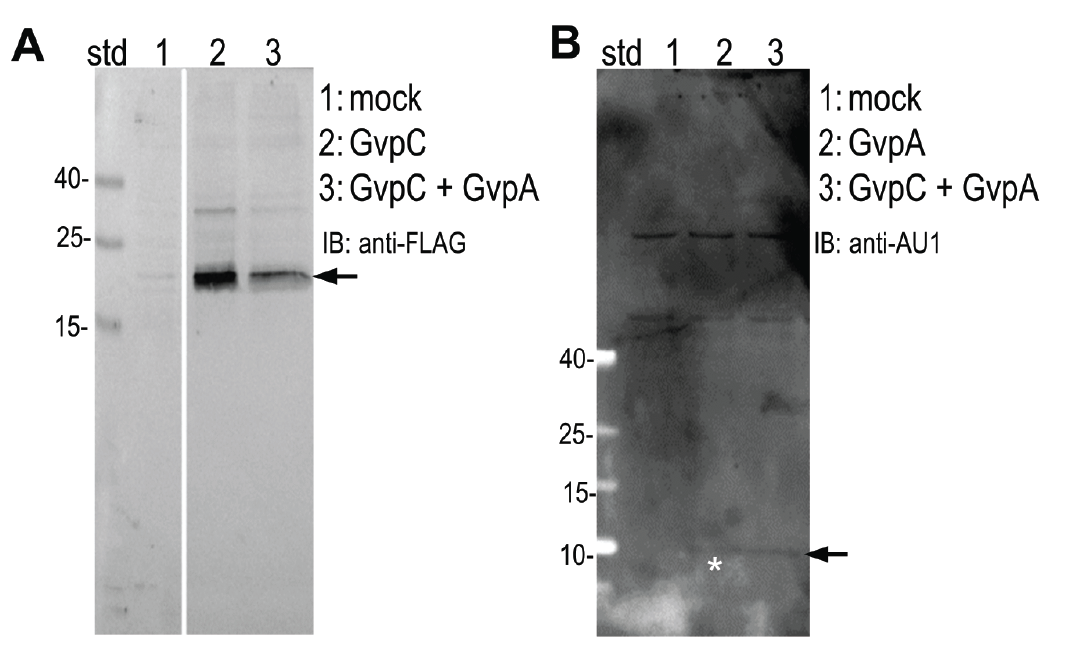Zigapusnik (Talk | contribs) |
Zigapusnik (Talk | contribs) |
||
| Line 144: | Line 144: | ||
<div styl="clear:left;"> | <div styl="clear:left;"> | ||
<figure data-ref="3.3.3."> | <figure data-ref="3.3.3."> | ||
| − | <img class="ui medium image" src="//2016.igem.org/wiki/images/a/a4/T--Slovenia--3.3.3.png" > | + | <img class="ui medium image" onclick="resize(this);" src="//2016.igem.org/wiki/images/a/a4/T--Slovenia--3.3.3.png" > |
<figcaption><b>. Expression of gas vesicle forming proteins in mammalian cells. </b><br/> Expression of (A) GvpC and (B) GvpA protein was determined by Western blot using (A) anti-FLAG and (B) anti-AU1, respectively. Expected sizes (marked with arrow) are 22,5 kDa and 8,5 kDa for GvpC and GvpA, respectively. | <figcaption><b>. Expression of gas vesicle forming proteins in mammalian cells. </b><br/> Expression of (A) GvpC and (B) GvpA protein was determined by Western blot using (A) anti-FLAG and (B) anti-AU1, respectively. Expected sizes (marked with arrow) are 22,5 kDa and 8,5 kDa for GvpC and GvpA, respectively. | ||
</figcaption> | </figcaption> | ||
Revision as of 23:41, 15 October 2016
nbsp; Gas vesicles
nbsp; Achievements
Addition of synthetic lipid microbubbles improved the responsiveness of cells to low-power ultrasound. Gas vesicle-forming proteins were expressed in mammalian cells where they improved sensitivity of cells to the ultrasound. Combination of the ectopic expression of mechanosensing bacterial channel MscS and gas vesicles-forming proteins sensitized cells to mechanical stimulation.
nbsp; Motivation
For activation of mechanoreceptors TRPC1 or MscS, a high-power ultrasound wave (900 Vpp) is required. Our aim was to improve responsiveness of cells to respond to the lower power of ultrasound as this would increase the selectivity, avoiding stimulation of endogenous channels and prevent cell damage. We decided to test gas-filled lipid microbubbles, since it has been reported that microbubbles can amplify the ultrasonic signal
Microbubbles are small gas-filled lipid vesicles which are used as contrast agents in medicine. Their size is in the range of micrometers. They work by resonating in an ultrasound beam, rapidly contracting and expanding in response to the pressure changes of the sound wave
nbsp; Results
Properties of microbubbles for example rigidity, are affected by the composition of the lipid membrane and the gas core. We prepared our lipid microbubbles from a mixture of DSPC:DSPE. Before sonication we added gas perfluorohexane (as described in the Protocols section), which facilitates compression and expansion of the microbubbles upon ultrasound stimulation (3.3.1.A). A heterogeneous mixture of microbubbles in the range from 5 to 100 µm in size were generated by this procedure (3.3.1.B ). Microbubbles are most effective in the size range corresponding to the resonance frequency of the ultrasound. However care has to be taken in the applied energy to prevent cavitation, that can sonoporate cell membranes.
(A)Schematic of a cell with an increased sensitivity to ultrasound stimulation in the presence of microbubbles. When exposed to mechanical stimuli the microbubbles contract and expand, resulting in activation of mechanosensitive channels on the cell membrane. (B) Mixed size distribution of lipid microbubbles was obtained. Stabilized lipid microbubbles were prepared by sonication and detected by microscopy.
Application of microbubbles to cells expressing mechanosensitive channel MscS significantly improved calcium influx after mechanical stimulation using low-power ultrasound wave (450 Vpp) (3.3.2.).

(A) Presentation of the ultrasound stimulation sequence and (B) signal parameters used for the stimulation. (C, D) Lipid microbubbles strongly enhanced response of cells expressing MscS channels. HEK293 cells expressing MscS channels were stimulated with ultrasound for 10 s and calcium influx was recorded in real time (D) using a confocal microscope. For comparison cells without ectopic MscS were used. Fluo-4 (D, green line) and Fura Red dyes (D, red line) were used for ratiometric calcium imaging. (D) Ratio (blue line) was calculated from fluorescence intensities of Fura Red and Fluo-4 using CaPTURE.
However, there are some drawbacks related to the use of lipid microbubbles, as their delivery requires injection into the selected tissue. Additionally lifetime of lipid microbubbles is limited in the tissue to tens of minutes and they need to be prepared freshly at least once a week.
To overcome the described drawback we thought of alternative options. One idea that initially looked too crazy to work was to use genetically encoded gas vesicles that are produced in bacteria. Bacterial gas vesicles have been used as contrasting agents for ultrasonography in animals
Gas vesicles are stable gas-filled structures, which provide buoyancy in a wide variety of planktonic prokaryotes
HEK293 cells were transfected with plasmids expressing both gas vesicle forming proteins, GvpA and GvpC. We could obtain GvpC from the Registry and added to its characterization, while the plasmid for GvpA could not be recovered and its coding sequence was synthesized using mammalian codon usage. Expression of both proteins was confirmed by the western blot (3.3.3.) and colocalization was observed by confocal microscopy (3.3.4.).

Expression of (A) GvpC and (B) GvpA protein was determined by Western blot using (A) anti-FLAG and (B) anti-AU1, respectively. Expected sizes (marked with arrow) are 22,5 kDa and 8,5 kDa for GvpC and GvpA, respectively.


